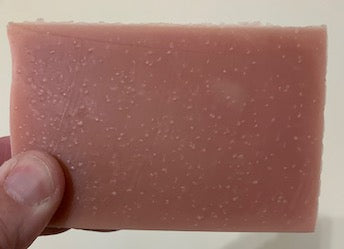
What Causes White Spots in Cold Process Soap?
What Causes White Spots in Cold Process Soap and How to Prevent Them
As a new soapmaker, one of the most common problems I was having with my soap was the appearance of white spots on my finished product. While these soaps are perfectly safe to use, the spots can be a nuisance when trying to create a smooth, uniform product.
In this blog, I talk about into what these white spots are, why they form, and how to prevent them.
What Are the White Spots?
White spots in cold process soap are usually one of two things: stearic acid spots or air pockets. Both have distinct characteristics and causes.
Stearic Acid Spots
In my situation, I discovered my white spots were actually steric acid spots. These are hard, waxy spots that are often white or pale in color. Stearic acid is a fatty acid that solidifies at room temperature. It is commonly found in fats and oils used in soap making, especially in high-stearic oils like palm oil, tallow, and butters such as shea and cocoa butter.
Why Do Stearic Acid or White Spots Form?
There are two reasons why steric acid spots form. The first is uneven melting and the second is temperature issues.
If your oils and butters are not fully melted and uniformly mixed, stearic acid can solidify and form spots as the soap cools and hardens.
Mixing at lower temperatures can also cause stearic acid to solidify prematurely. High-stearic fats need to be well-melted and kept at a consistent temperature to avoid solidification.
Preventing Stearic Acid or White Spots
To fix this problem with my soaps, I first melted just my solid oils and butters. I melted them at a higher temperature than I would normally use and I made sure they were completely melted and mixed well. There should be no trace of any white solid particles left behind. The ingredients should be completely liquified.
I then kept the temperature of my oils and lye solution within the recommended range (typically between 100-120°F or 37-49°C). Consistent temperature helps in even distribution of stearic acid.
I stirred the mixture slowly and steadily, ensuring all components were well integrated before bringing the soap to trace.
In my situation, this solved my problem with white spots. If you follow these steps and still end up with white spots, your issue may be air pockets.
Air Pockets
Air Pocket are small, irregular white or translucent spots caused by air trapped in the soap batter during mixing. They are usually more noticeable when the soap is cut.
Why do Air Pockets or White Spots Form?
There are three ways air pockets can form within your soaps.
- Improper Mixing: Inadequate mixing can trap air bubbles in the soap batter.
- Pouring Techniques: Pouring the soap batter too quickly or from a significant height can introduce air bubbles.
- Thick Trace: If the soap batter is too thick before pouring, it can trap air bubbles that do not rise to the surface.
How to Prevent Air Pockets or White Spots
Before turning your stick blender on, tap it on the bottom of your mixing bowl to release any trapped bubbles. Use a gentle up and down motion rather than vigorously stirring, which can introduce air.
Pour the soap batter slowly and close to the mold to minimize air incorporation. It helps to use a spatula to break the fall of the batter as you pour it into the mold.
Once the batter is in the mold, gently tap the mold on a hard surface to release any trapped air bubbles. I do this every time I create my soaps.
Avoid reaching a thick trace before pouring. A medium trace allows for a smoother pour and reduces the risk of air pockets.
Now You Know
By understanding the nature of white spots in cold process soaps, and their causes, you can take proactive steps to prevent them. Ensure thorough melting and mixing of oils, maintain proper temperatures, and use gentle mixing and pouring techniques. With these practices, you can achieve beautifully smooth and consistent soap bars, free from unwanted white spots.
Have you encountered white spots during your soap making process?
Have you used any of the techniques above to help solve these spots?
Comment below and let me know!
Happy Soap Making!